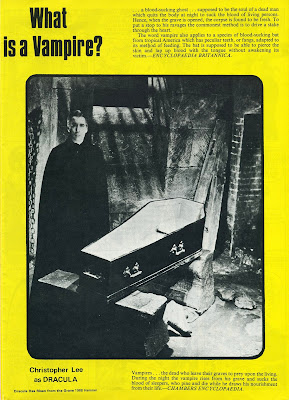"If God had meant us to be nudists, we would have been born without clothes." -- Forrest J Ackerman in Continuum
One look at Forrest J Ackerman's resume reveals a varied and multifold list of work. There's his most famous accomplishment, editor of the original FAMOUS MONSTERS OF FILMLAND magazine, There's his work as an author's agent. There's his litany of fiction and non-fiction. And . . . there's his entry as a nudist.
Did I say nudist? I most certainly did! FJA unabashedly claimed his stint at a nudist colony back in the 1960s was actually "research" for an article. I guess it really doesn't matter if it was an assignment or a freelance job, does it?
In his autobiographical Forrest J Ackerman, Famous Monster of Filmland, published by Imagine, Inc. in 1986, he casually states: "I, for instance, am not embarrassed to let you know that, years ago, after researching an article called "Brave Nude World", which was originally published in a nudist magazine [unnamed here] and later reprinted in Fantastic, a companion to Amazing at the time, I frequently frequented [sic] a nudist camp on Sundays for about 5 years."
Man, that's a lot of reasearch! In an attempt at a sort of professional validation, Forry went on to say that famous science fiction author Theodore Sturgeon made "no secret" about being a nudist, as well. Oh, okay.
In an earlier, unrestrained (but oh, so entertaining) bio-fest titled Amazing Forries, published in November 1976 by Metropolis Publications, FJA included nudism on the list of "Things I Am For".
It's no secret that Forry had an eye for beauty, especially of the young female kind. For instance, he professed ebullient support for a young fan, Trina Petit, who was later to be known as underground cartoonist Trina Robbins, and was credited by Forry as the designer of the strip of cloth that became Vampirella's costume.
 |
| Trina Petit/Robbins' letter in FAMOUS MONSTERS #6. |
Then there was the strange promotion of another up and coming female fan by the name of Heidi Sahi. Miss Saha was a regular member of fantasy conventions in the early 1970s, many times appearing in costume as such heroines as Sheena, Queen of the Jungle, and, most famously, Vampirella.
For a while, Forry was unrelenting in the promotion of his favorite nymphette, even to the point of having James Warren publish the now-notorious, AN ILLUSTRATED HISTORY OF HEIDI SAHA, in 1973, which left many a' monster fan scratching his head as to its significance.
 |
A page from AN ILLUSTRATED HISTORY
OF HEIDI SAHA. |
 |
A photo of Heidi in her Vampirella costume (top).
Pictured below is a young scream queen
later to become known as Brinke Stevens. |
Another quirk of Forry's was for him to be seen in many photographs clutching a copy of FAMOUS MONSTERS OF FILMLAND in a seemingly neverending shameless plug of his magazine. This being a regular practice, one could be lead to speculate that Ackerman, during the course of his "research" on nudist camps, had only his copy of FM between him and his companions.

























































